#bullet journaling helped my creativity
Text
so for those of you who don't know, I was recently diagnosed with ADHD-I. So far, I think my favourite thing that I've learned is the idea of "embrace the pivot".
Have you ever found a productivity system that works for you (whether it be your Google calendar, bullet journaling, agenda-ing, etc), and you're so pumped because it's like finally! Now I can actually get some stuff done! But then time passes, days or weeks or years, and the novelty of it runs out, and then it kind of just... Stops working. It can be so frustrating, because this thing that used to work no longer works for seemingly no reason.
But, that isn't a failing of the thing, that thing worked for a certain amount of time, and that's good! I used a massive agenda in my first year of uni, and it kept me on track for all my assignments. My second year agenda? Barely touched it. Instead, I started to use a bullet journal, and that was the thing that helped me through most of the year. But as time went on, my spreads got less creative, and in the final term, I didn't even want to touch it because it was too much work. So I switched to Notion.
The agenda didn't fail me, and neither did the bullet journal, it just worked for a certain amount of time. And when that time inevitably runs out, you can just say, "thank you for serving me for so long, I'm going to pivot to the next thing." And then you do it without feeling like you should try harder or like that thing failed you.
This doesn't just have to apply to productivity either. Systems, tools, habits, hobbies, coping mechanisms.. They all serve their purpose. It's okay to let them go when the time comes.
#cy says stuff#adhd#also i think it's fun because then you learn new skills too#bullet journaling helped my creativity#notion taught me how to design templates based on my own preferences as opposed to presets#1k#2k#3k#4k#5k
16K notes
·
View notes
Text
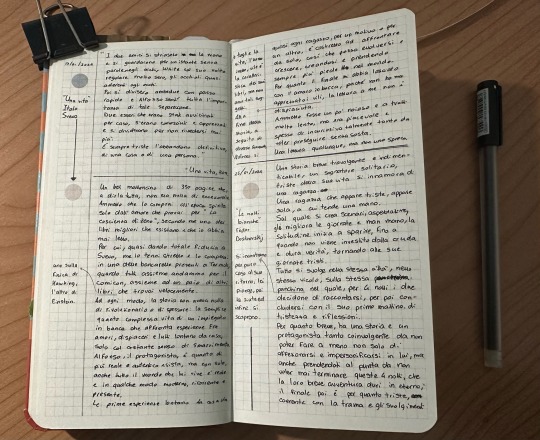
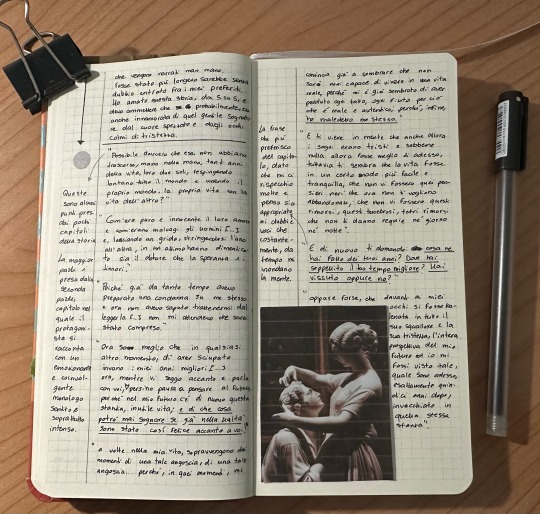
commonplace
#art#help my sanity#books and libraries#commonplace#commonplace book#bujo#bullet journal#journal#planner#writing#commonplacing#commonplace journal#creative writing#art inspo#studytbr#study aesthetic#studyinspo#aesthetic
173 notes
·
View notes
Text


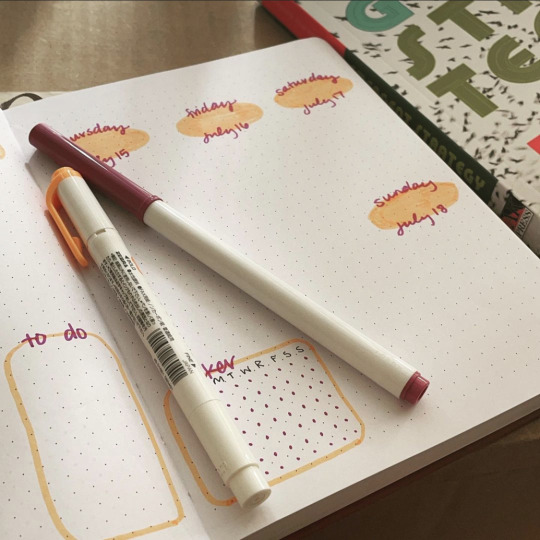
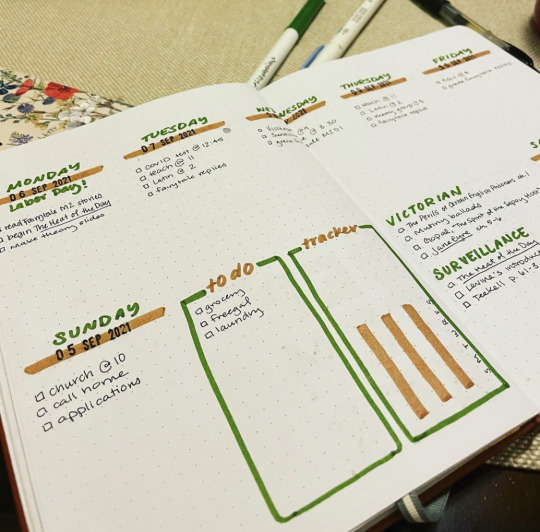
i was setting up my bullet journal for June this afternoon and still thinking about previous posts I reblogged about the gentrification of journaling and what is 'necessary' to start journaling, so I decided to do something very unusual for me and share a few completed pages. The top two images are from my current bujo, and the bottom two are from my last one. I had no pictures of my first one, which is a shame. You'll notice I have completely dropped the trackers, rearranged the layout (no more monthly pages!), and started writing snippets about my day in the space leftover. For a year, I also wrote my readings for class in a different space than daily chores, which helped me distinguish between meetings and homework. In my first bujo, I also had a separate section for recording what I ate for dinner (which was sparingly used).
Bullet journaling may not seem worth doing anymore for me, since I have all but resorted to a common weekly planner layout without any bells or whistles, but I still find it works for me. It doesn't take me very long to set up a month (maybe 20 minutes?), nor do I have to stick to a layout if I choose to switch it up. For instance, the top right photo shows that I tried a-page-a-day set up to little success - I wanted to fill all that space with detailed journal entries as a new year's resolution, but by the time February rolled around, I was back to writing two or three bullet points, if anything. I reverted back to weekly spreads when planning the rest of February. I also fill pages from the back with notes from lectures, meetings, and brainstorming sessions, so I usually finish a journal in a year's time. All my supplies are from my undergrad days, and I'm not sure I'll rebuy things like the mildliners or the huge Stabilo pen pack when they dry up.
Does having the markers make it fun? Sure! Will I someday returned to printed planners? Maybe! Do you need this stuff to be a proper bullet journaler? Absolutely not.
#bujos#bullet journals#journals#journaling#my journals#not that my 2 cents mattes much here lol i am still using the markers#I also keep an inconsistent diary and a creative journal which helps winnow my needs for my bujo down
21 notes
·
View notes
Text

namgikook bullet journal spread ✨
#hello I’m super inactive here sorry#if you’ve sent me an inbox or dm and I haven’t replied it’s not personal I truly will go days without checking and then forget….😩#I’ve not necessarily been busier? but I’ve diversified the apps I scroll on and have a steady kdrama rotation#but one cool thing that’s helped me be more present and document my mood health and life has been this bullet journal#i love that I have this small creative outlet that’s low pressure#and also is the new thing I spend money on oops#like did I really need 60 gel pens? it was $5 from five below but still 👀#anyways I hope I will be active during comeback and cultivate an online space for myself that feels welcoming again
9 notes
·
View notes
Text
The Dollhouse Diaries
Real Life In Plastic Tip #6:
ෆTime Management for Neurodivergent Girly Girls and Boujie Hyperfemmesෆ

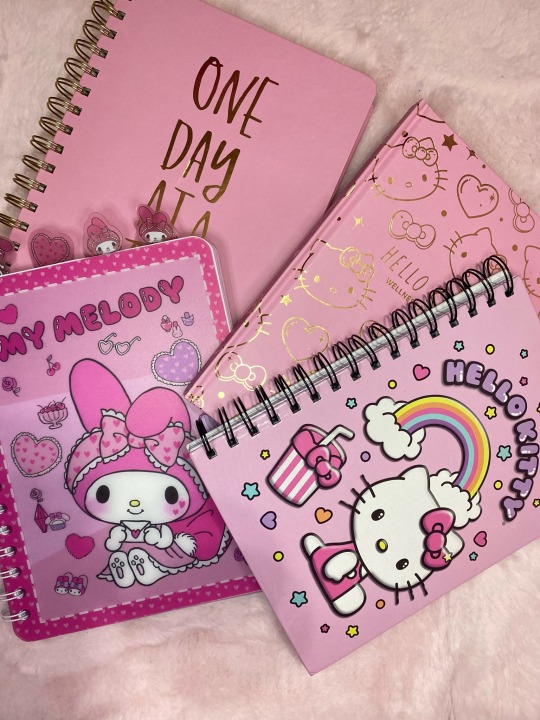
This is the pretty girl era of having time management under control. The key is to learn how to live in the moment while also being discipline enough to move on to the next task as needed. I know that sentence was as daunting to read as it was for me to write ૮꒰ྀི⊃⸝ ⸝ ⸝⊂꒱ྀིა I guarantee I gotcha *Chaeyoung voice*
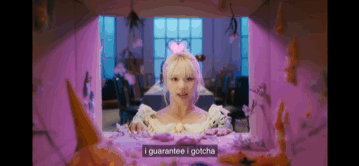
First Things First: Go 1 Week At a Time!! (every 3 days if an entire 7 is too much or your schedule is unpredictable, like mine)

Build a simple list of all the things you have to do and that you would like to do. Its much easier to get it all out on the table so you can donate more of your brain power to sorting things, rather than holding things.
Put all of the things listed on a calendar: Most important first things first! This means things like health appointments,work schedule, birthdays, holidays that you celebrate, classes, or anything that involves not only your time but other’s as well. Then after that put the elective things second; Nail appointments, shopping trips, dates with friends, etc. Lastly, put the things you would like to incorporate into your daily routine; We talking skincare, any hobbies you may have like drawing/painting/sculpting/reading/blogging, any form of exercise, etc.
Once the week or however much time you have scheduled out is done on your overall calendar, then its time for marrying it to your life.
Marrying your schedule: Planner apps, Physical Planner, Dry Erase Boards and Bullet Journals
Choosing your medium at keeping up with your schedule is very important. You may have to try them all before you get comfortable with something. I have tried them all and I’ve found that the main one that truly stuck with me was the app/website Notion. I like it because its fully customizable and you can use it at your own pace. Every week or every day may not be super eventful and so it drops the guilt and shameful feeling of not filling up pages every single day.
Here is what all I use and the way I use them:
Notion <3 I use it as my overall journal. I use the apps on my ipad/phone to check if I’m not home and I can use the website on my PC when I’m home and relaxing. I like it because its very versatile. Think of it as a digital journal combined with similar mechanics of tumblr. I use it for literally everything. There are a lot of videos that can show off all of the cool things Notion can be used for but this is the video that personally helped me learn it quickly

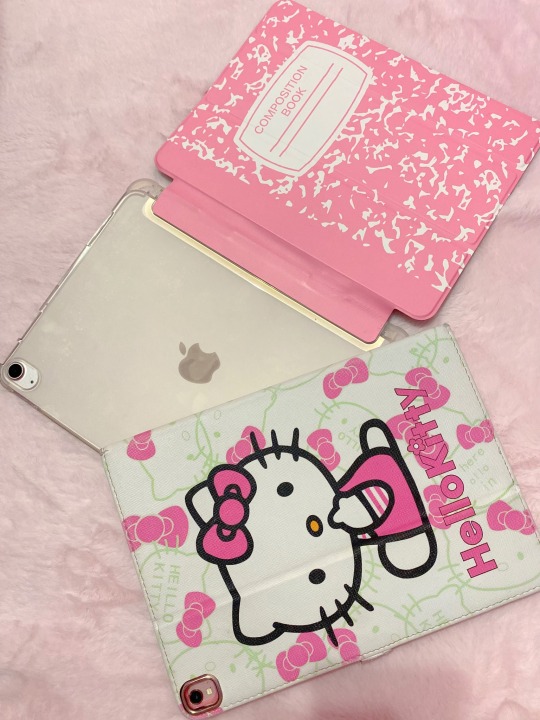
Bullet Journals <3 I have about 3 journals and I love them because I get to customize things with cute stickers and it gives very fun scrapbooking vibes. Because I use Notion as a all over planner I can use my BUJO’s for more fun and creative things. I usually use these for all of my cute ideas and things thats in my mind and aesthetic wishlists and such. Its very therapeutic to take time out to be kawaii and glamorous and just put cute thoughts on to paper! I mainly use it for kpop inputs, my fav shows, wishlists, dates and etc.
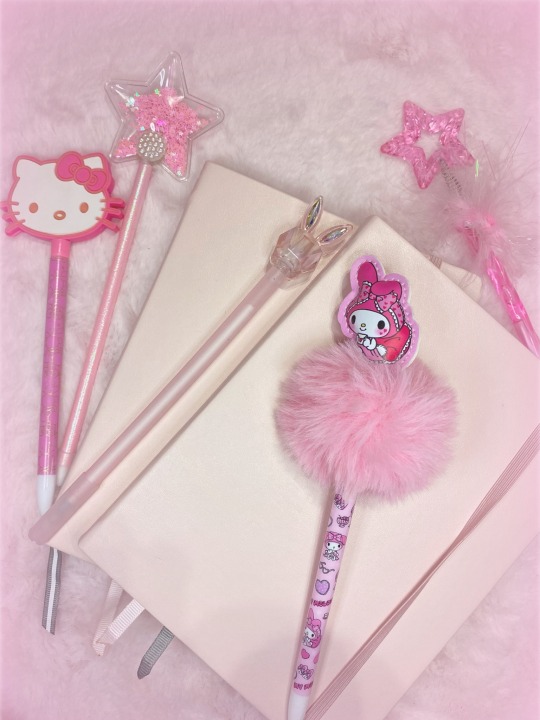
Dry erase board <3 I use this as a overall daily top important to-do list! Sometimes I dont always open my notion if I dont have anything extremely important coming up but there may be some things I need to keep on my mind to do for that day. The way my neurodivergency is set up I need to keep the most important things always in my face or I could forget everything. So, I put things on there like get a new tire, pick up order from bath & bodyworks, put clothes in the dryer, wash dishes, and etc. Daily tasks like that usually goes on my dry erase board
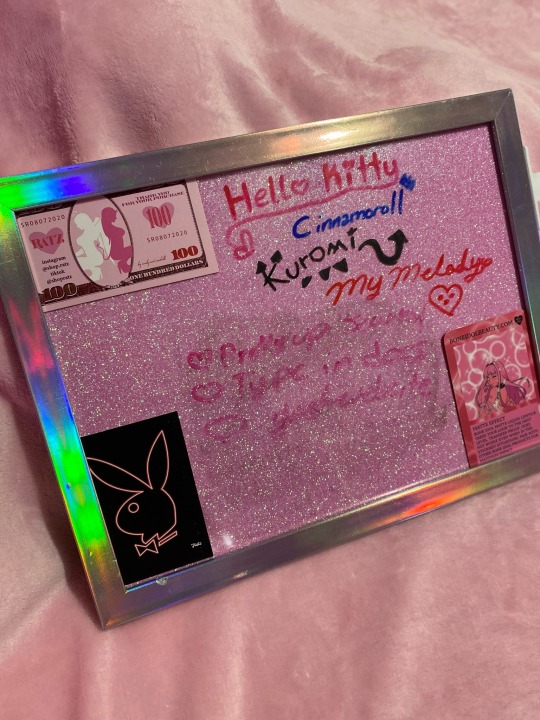

Remember at the end of the day dont be too hard on yourself and your schedule! Move at your own pace and always set yourself up for success. Scheduling is ideally suppose to calm you and be a tool to improve your life; not stress you out. If at any point you begin to feel overwhelmed just stop and recenter yourself and your life. I felt overwhelmed at first myself and that was because I was trying to keep up with a hyper organized and productive version of myself that I needed to give more patience to develop. Let this come organically to you and not because you are trying to keep up with what u feel everyone else is doing, or to the future self you are going to inevitably become. Happy scheduling, Dollmate!

#dollhouse dairies#doll advice#bimbydoll diaries#nuerodivergent#neurospicy#adhd#advice#pink aesthetic#soft aesthetic#journaling#bujospo#girl blogger#notion#y2k aesthetic
715 notes
·
View notes
Note
I've had ideas for stories I want to write, I write down a bullet point outline, but then I struggle with the actual writing bit. I can think and imagine a full scale plot with hooks, twists, etc but there's a block.
I've always struggled with getting my thoughts put into words that make sense for how I see it. Or just putting thoughts into words in general.
Do you have any advice that may help?
Plot Fleshed Out, Can't Write
When you understand plot and story structure, have the plot fleshed out and outlined, but still can't write, it's almost certainly because you're lacking one or more of the following:
1 - Inspiration - Your story's outline is sort of like the wooden studs, struts, joists, and beams that serve as the underlying structure of a house. You can have detailed instructions for how to build the actual house, but if you don't have ideas for what materials to use to build the walls, the kind of roof to put up, what type of floors to put in, what color to paint the walls, and how to decorate everything, you'll only ever have a structure. That's why one of the most important things you can do as a writer is make sure you have a full creative well at all times. If you're struggling to take a detailed outline and turn it into an actual story, it's probably because your creative well is dry. You have the structure, you just don't have ideas for what to do with it. So, spend some time Filling Your Creative Well and you'll find that ideas for what to actually write come pouring in.
2 - Motivation - Believe it or not, you can have a detailed outline and a full creative well providing you with lots of ideas for what to write, and you can still be unable to actually write anything. All kinds of things can hamper our motivation to write, from self-doubt and distraction to not feeling well or life getting in the way. My posts: Feeling Unmotivated with WIP, Worried About Writing Style, Delaying Writing Out of Fear, Writing and Depression, Would Rather Be Doing Other Things can help with some of the common motivation zappers.
3 - Excitement - Even with a detailed outline, a great story idea, tons of great ideas, and plenty of motivation to write, if you're not excited about your idea--about the characters, setting, plot details, all of it--you may find yourself struggling to actually write. My posts: Guide: How to Rekindle Your Motivation to Write, Getting Excited About Your Story Again, and
3 - Excitement - Even with a detailed outline, a great story idea, tons of great ideas, and plenty of motivation to write, if you're not excited about your idea--about the characters, setting, plot details, all of it--you may find yourself struggling to actually write. My posts: Guide: How to Rekindle Your Motivation to Write, Getting Excited About Your Story Again, and Getting Unstuck: Motivation Beyond Mood Boards & Playlists has some ideas for how to reignite the spark of excitement for your story.
4 - Practice - Knowing how stories work and being able to actually write one are two completely different things. Kind of like you can know how to read sheet music and understand how to play a piano, but that doesn't mean you can just sit down and play a beautiful, flawless concerto. Writing requires practice, and practice means you have to spend a lot of time writing not-so-great stuff before you can write great stuff. But if you never take the time to write the not-so-great stuff, or if you never start writing because you feel like what you write has to be immediately perfect, you'll never get the practice you need. So, just start writing. Do writing prompts. Write fan-fiction. Journal. Any kind of writing will exercise your writing muscles and get them into shape.
5- Energy - Having the physical and mental energy to write is just as important as everything above. If you're lacking in energy, you're not going to feel like writing when you sit down and try to write. So, self-care is super important when you're going to be writing. Make sure you're getting enough sleep, exercising, and eating right. Try to avoid doing things that sap your physical and mental energy if you know you're planning to write later. Take some time to figure out the time of day that works best for you energy-wise and try to schedule your writing time then.
Happy writing!
•••••••••••••••••••••••••••••••••
I’ve been writing seriously for over 30 years and love to share what I’ve learned. Have a writing question? My inbox is always open!
LEARN MORE about WQA
SEE MY ask policies
VISIT MY Master List of Top Posts
COFFEE & COMMISSIONS ko-fi.com/wqa
176 notes
·
View notes
Text
A Step-by-Step Guide to Crafting a Compelling Storyline

I'll warn you, this is a long one. I kind of took 'comprehensive guide' a little too seriously.
You have a fantastic concept burning at the edges of your imagination, a collection of characters whispering their stories to you, and a world just waiting to be explored. But how do you weave all these elements into a story that grips readers and refuses to let go? The answer lies in effective plot planning.
A well-crafted plot isn't just a sequence of events; it's a carefully orchestrated symphony that takes readers on an unforgettable ride. Whether you're an experienced writer or someone trying to start their first book, here are my personal steps to crafting a compelling storyline with good plot planning.
Step 1: Idea Generation and Conceptualization
Every great story begins with a spark of inspiration. It's that moment when an idea ignites in your mind and beckons you to explore its potential. The journey from a fleeting thought to a fully-fledged concept is an exhilarating one, and it all starts with idea generation and conceptualization.
Techniques for Idea Generation
Mind Mapping
Grab a piece of paper or use a digital tool to create a mind map. Write your central idea in the middle and branch out with related concepts, characters, themes, and settings. Mind mapping can help you visualize the connections and possibilities within your idea.
Bullet journalling
Bullet journalling is my personal favourite way to generate ideas for your WIP. Get a piece of paper or open a Word/Docs document and create three different sections: world, characters, and plot. Now add facts to each of those sections that you've come up with so far.
You can even go a step ahead and create more detailed sections, for example, you could do this for your different characters or different places in your world. Usually, one bullet point leads to the next and once you have an idea of everything you've already established you'll naturally start adding more to it.
Blurting
Talk to someone about your WIP, or pretend that you're talking to someone and write down everything that comes to mind. You can even use AI tools like ChatGPT and ask it to hold a conversation with you about your WIP. Tell it to ask you questions along the way, this will get the wheels turning and even help fill plot holes.
Prompts and Challenges
Explore writing prompts or challenges to spark your creativity. Websites, books, or even random word generators can provide the nudge you need to generate fresh ideas.
Refining Your Concept
Once you have a collection of ideas, it's time to refine and shape them into a cohesive concept.
Identify Themes
What themes or messages do you want to convey through your story? Is it a tale of redemption, the power of friendship, or the consequences of ambition? Pinpointing your core themes will guide your storytelling and also give you a clear image of the end goal.
Find Your Angle
Consider what makes your idea unique. How can you approach a familiar concept from a fresh perspective? For example, if you're doing a classic murder mystery, what makes your book different from others? Take some time to look up titles similar to your WIP and find any repetitive themes/patterns.
Maybe most murder mysteries end with the partner being the killer, or maybe the fantasy books written in the same mythology as your WIP's all involve a war. Knowing what is currently a popular trend in the market can give you a clear idea of where you can be different from comparable titles. This is especially important for genres like horror and romance.
Develop a Premise
Your premise is the foundation of your story. It's the "what if?" question that drives your narrative. For instance, "What if an ordinary high school student discovers they have the ability to control time?" You need to have a solid premise before you even think about writing your story.
Step 2: Character Development and Motivation
Characters are the beating heart of your story, and crafting them with depth and authenticity is key to creating a narrative that truly captivates. Your characters often leave more of a lasting impact on your readers than the plot itself.
Think of it this way: a good plot will get you readers, but memorable characters will get you fans. Some of the largest communities in the book space all run on the readers' fondness for certain characters rather than the story itself. Yes, your story and the way you tell it is very important, but nobody wants to listen to the story of a boring person.
Bringing Characters to Life
Personal Histories
Delve into your characters' pasts. What experiences shaped them into who they are today? A traumatic childhood or a life-changing event can influence their motivations and behaviours. Maybe your antagonist has a soft spot for single parents because their mother was the only person who cared for them. Maybe the love interest seems like a sunshine character because they feel the need to always seem put-together and perfect.
Physical Traits
This might sound obvious enough, after all a character's appearance is the first thing people think of when visualising, however, many authors fail to have a clear image of their character's physical traits which can lead to inconsistent or boring descriptions. Sure, your protagonist can have bushy hair and brown eyes, but what else?
Think about their body type, height, fashion sense, the way they carry themselves, walk, and sound. Do they have a random mole at the back of their neck? Do they always smell like a certain perfume because their dead father gifted it to them? It's important for you to have a clear image of who you're writing.
Strengths and Flaws
Just like real people, characters have strengths and weaknesses. These traits affect their decisions and interactions. A courageous hero might also struggle with recklessness, adding complexity to their personality. It's easy to create 2D characters by using tropes or shallow descriptions 'an all-powerful villain' 'the chosen one who trained their whole life and is perfect', but 3D characters are what will actually catch your readers' attention.
There's a reason why people often love the grey characters, the anti-heroes or anti-villains. Those who have complex personalities that make them seem human. This makes us empathise with the characters, and as a writer, it also helps you think of your characters as real people with flaws and problems.
Motivations: The Why Behind the What
Goals and Desires
What do your characters want? Their goals drive the plot forward. A detective's desire to solve a mystery or a scientist's quest for a groundbreaking discovery sets the narrative in motion. Why is your protagonist doing what they are doing?
You could simply give yourself a generic answer like 'they want to save the people' or 'they're a good person' but this can lead to confusion in the long run. If as the writer you yourself can't understand your character's goals it will get very hard to showcase them to your readers. Try to pick apart each character and genuinely consider why they are the way they are.
Inner Conflicts
Characters often grapple with inner turmoil – the clash between their desires, values, and fears. This inner conflict adds layers of intrigue and reliability. Maybe your protagonist realises the antagonist's qualms with the government are actually valid and suffers from moral conflicts as they contemplate whether or not they are the 'good guy'. Inner conflict adds dimension to your characters which in turn makes it easier for your readers to empathise with them.
Step 3: Outlining the Key Plot Points
Now that you have a clear idea of what you want to write and who you want to write it with, it's time to consider the how. You have a story, but how do you want to tell it? Break down the key plot points that shape your narrative, creating a roadmap that guides your characters through their trials and triumphs.
The Building Blocks of Plot
The Inciting Incident
The spark that ignites your story. It's the moment when your protagonist's world is disrupted, setting them on a path of change. For example, in "The Hunger Games," Katniss Everdeen's sister being chosen for the Games is the inciting incident that propels her into the arena.
This can be a little harder to recognise in genres outside of SFF and horror. For a thriller novel, this moment could be the moment your protagonist uncovers a sketchy detail in their relative's death. In romance, it could be the moment your protagonist is introduced to the love interest.
Turning Points
These are pivotal moments that shift the course of your narrative. They introduce new challenges, reveal secrets, or force characters to make crucial decisions. Think of them as the gears that keep your story machine turning. It's important to have some sort of turning point in your story to keep things interesting.
Maybe the character your protagonist was suspecting throughout the first half of the book ends up having a solid alibi, or a seemingly innocent character suddenly seems sketchy.
The Climax
The peak of tension and conflict. It's the moment your characters face their biggest challenge and must make their ultimate choice. In "The Lord of the Rings," the climactic battle at Mount Doom decides the fate of Middle-earth. In a murder mystery, this can be the moment the real killer is unveiled, or in a rom-com, it could be when the love interest moves to a new city to follow the protagonist.
Falling Action and Resolution
As your story winds down, the falling action ties up loose ends and provides closure. Readers witness the aftermath of the climax, and the characters' arcs find resolution. This is the bit where you make sure you aren't leaving any plot holes behind. Remember that random character your protagonist suspected at the start of the book? What's their alibi, why did they suddenly get out of the picture?
Structuring Plot Points
Introduction of Stakes
Introduce what your characters stand to gain or lose early on. This creates a sense of urgency that propels them forward. What if your protagonist fails to complete their missions? What if the detective never unveils the killer's identity? What if your protagonist doesn't win over the love interest? Show your readers the worst possible outcome early on so they know why they should be rooting for your protagonist.
This doesn't necessarily have to be something big or scary. In Harry Potter, many of us wanted Harry to stay at Hogwarts because his life with the Dursleys was cruel and he deserved happiness. That was a small yet significant stake that made the readers empathetic and silently root for Harry.
Foreshadowing and Setup
Plant seeds of future events throughout your story. Foreshadowing builds anticipation and adds depth, making later plot developments more satisfying. I have written a lot of blogs that either cover or briefly mention foreshadowing so I'm going to keep this point a little short.
Foreshadowing helps your readers slowly piece everything together and have that 'I knew it!' or 'how did I not see this coming?' moment. It might also encourage them to turn back and reread your work to focus on the little hints you left throughout the book. Foreshadowing is especially important in murder mysteries.
Step 4: Subplots and Secondary Storylines
Subplots and secondary storylines are the secret ingredients that transform a good story into an unforgettable masterpiece. They add layers of intrigue, provide character development opportunities, and keep readers eagerly turning pages. If you're confused about what is a subplot and how to create one you can visit my previous blog that focuses on this topic.
The Role of Subplots
Enriching Character Arcs
Subplots allow secondary characters to shine. They can showcase different facets of your characters' personalities, revealing their strengths, weaknesses, growth, and relationships.
Theme Reinforcement
Subplots can explore and reinforce your story's themes from various angles. For instance, a romantic subplot can underscore the theme of love and sacrifice, in turn making your protagonist’s heroic death at the end of the novel seem more impactful. We all know Pepper’s reaction to Tony’s death in End Game made the moment more emotional.
While creating subplots and considering which one might be relevant to your book you should think of how this subplot would impact your end goal and whether it would help emotionally connect with your readers.
Parallel Journeys
Subplots can create parallel journeys that mirror or contrast with the main plot. This dynamic adds depth and resonance to your storytelling. Maybe the antagonist’s assistant has a similar backstory to your protagonist but while the protagonist was rescued by the government they were taken in by the antagonist. As the two geniuses face each other your protagonist can’t help but consider whether they would still be fighting for the ‘good’ side had their roles been switched.
Balancing The Main Plot and Subplots
Interconnectedness
Subplots shouldn't feel disconnected from the main plot. Instead, they should interact and influence each other, creating a harmonious narrative flow. Your subplot could help bring a satisfactory end to a certain arc of your story, or it could sow the roots for the important climactic moment of your book.
Pacing and Tension
Strategically introduce subplots to maintain pacing and tension. They can provide moments of relief or heightened drama, enhancing the overall reading experience.
Character Integration
Ensure that characters involved in subplots maintain relevance to the main plot. Their actions and decisions should contribute to the overarching story, even as they pursue their own paths. You should also think about whether or not your character is overshadowing the protagonist. In Harry Potter there were several characters such as Ginny, Luna and Neville with subplots and backstories of their own, however, they never overshadowed Harry’s tale.
Step 5: Crafting Scenes and Sequences
Welcome to the realm where the magic truly comes to life – crafting scenes that resonate, captivate, and propel your story forward. Scenes are the building blocks of your narrative, each one a window into your characters' world and emotions. They help infuse your story with tension, emotion, and unforgettable moments.
Again, this is a topic I’ve covered separately in another blog so I won’t go into too much detail here.
Scene Structure and Elements
Objective and Conflict
Every scene should have a purpose – a clear objective that drives the characters. Introduce conflict that challenges their goals and motivations, creating tension that keeps readers engaged.
Emotion and Stakes
Characters' emotions are the heartbeats of scenes. Amplify emotions by highlighting what's at stake for the characters. Whether it's a heated argument or a tender moment, emotions draw readers in.
Sequences: Crafting a Flow
Cause and Effect
Scenes connect through cause and effect. Each scene's outcome sets the stage for the next, creating a seamless flow that propels the narrative. A character's choice in one scene can reverberate and shape subsequent events.
Rising Action
Craft sequences with escalating tension. The stakes should intensify, drawing characters deeper into challenges and dilemmas. This creates a sense of anticipation that keeps readers eagerly turning pages.
Step 6: Mapping the Journey: Creating a Visual Plot Outline
Visualising your plot, characters, and world can be very hard sometimes. Let's be honest, words can only do so much and if you don't have a clear idea of what you want to show your readers you can end up going down a path of 'telling' them everything. This can take away from the point of your story and end up boring your readers. If you find it hard to visualise where you're going with your book, here are some tips that can help.
Visual Tools for Plot Planning
Timelines and Flowcharts
Create a timeline that outlines the sequence of major events, from inciting incidents to resolution. Flowcharts visually depict the interconnectedness of plot points, making it easy to track the evolution of your story. You can also cut out or add bits depending on how far along you are. This will also help you keep track of what scene/development should be introduced when and why.
Index Cards or Post-Its
Write down key scenes, plot developments, and character arcs on individual index cards or sticky notes. Arrange and rearrange them on a board or wall to visualize the narrative's flow. You can also do this if you're confused about the climax of your novel by adding different ideas to the post-its and putting them alongside the rest of the book's plot to see what things would look like from a reader's perspective.
Infusing Creativity
Playlists
Curate a playlist that captures the mood and emotions of your story. Music has the power to transport you to the heart of your narrative, helping you channel the right atmosphere while plotting. You can listen to this playlist every time you sit down to write WIP. With time, this will also help you overcome writer’s block since you can put on this playlist every time you struggle to get into the right writing mindset.
Moodboards/Pinterest Boards
Create a visual feast by collecting images, aesthetics, and visuals that embody your story's essence. Platforms like Pinterest allow you to craft moodboards that serve as visual touchstones. I would recommend creating a separate pinboard for every character so you can get a clear idea of their vibe and appearance. You can even refer to these every time you're writing about or from the perspective of a new character.
Step 7: Flexibility and Adaptability
As you embark on your writing journey, remember that stories have a life of their own. Embracing flexibility and adaptability is your compass through uncharted territories.
Allow characters to surprise you, let plots pivot, and themes emerge. Balancing structure with spontaneity ensures a dynamic narrative that resonates deeply. Listen to your characters, explore ethical complexities, and evolve alongside your story.
By staying open to the unexpected, you infuse your writing with authenticity and richness. Your plot outline is a guide, but your characters and themes have the power to shape the course. Embrace the unpredictable, and watch your story flourish beyond your imagination.
I hope this blog on A Step-by-Step Guide to Crafting a Compelling Storyline will help you in your writing journey. Be sure to comment any tips of your own to help your fellow authors prosper, and follow my blog for new blog updates every Monday and Thursday.
Looking For More Writing Tips And Tricks?
Are you an author looking for writing tips and tricks to better your manuscript? Or do you want to learn about how to get a literary agent, get published and properly market your book? Consider checking out the rest of Haya’s book blog where I post writing and publishing tips for authors every Monday and Thursday! And don’t forget to head over to my TikTok and Instagram profiles @hayatheauthor to learn more about my WIP and writing journey!
#hayatheauthor#haya's book blog#haya sameer#haya blogs#writers on tumblr#writer community#writer tools#writer blog#writer stuff#writer wednesday#writer tips#creative writing#writers of tumblr#writerscommunity#writeblr#writing community#writer spotlight#writer things#writing prompt#writing tools#writing stuff#writing#writing life#writing inspo#writing help#writing advice#writing inspiration#writing ideas#writing things#writing tip
217 notes
·
View notes
Text
VAMPIREKIN TIPS

Hey fellow vamps! Here is a list of tips that give me euphoria but absolutely feel free to modify these to your liking. Vampires can have any style and vibe so remember to do what feels right for you!

Eat foods with blood in them or rare beef! Blood sausage and blood pudding, to name a few! Here’s a wiki for more options: https://en.wikipedia.org/wiki/Blood_as_food
Drink red drinks: energy drinks, hibiscus tea, pomegranate juice, cranberry juice, etc
Enjoy the feeling of biting into ripe fruit - so easy, very satisfying… I feel like it’s alike to fangs on skin
Wear black cloaks / clothes / gothic wear / gothic lolita fashion / etc etc
Keep a journal all about your vampirekin. Decorate it and such! I use this as a bullet journal and it’s mainly in use at night.
Music! Make some vampiric playlists for yourself. I recommend classical and organ music
Look after your skin! “Vampire skin”

Get and light some red candles, black candles or, even better, bleeding candles. Bleeding candles can be found on Etsy or Amazon!
Exploring decades of history and researching about historical accounts of vampires
Play A Thousand Year Old Vampire! An amazing tabletop journaling solo DnD game where you play as a vampire and write a journal for them. I can’t explain to you how euphoric this is… just amazing.
Vampire DnD in general is euphoric to me (putting this here incase folks can’t afford the precious game!) Look on https://itch.io for free solo DnD and other indie games!
Read vampire stories, watch vampire movies!
Wear fake fangs and get some fake blood for comfort <3
Create a Pinterest board based on your vampirekin
Decorate your room with gothic items! Interior design goes a long way - for example, I keep a few Halloween decorations up that are bat and vampire related!
If you’re spiritual, get vampire / gothic tarot decks!
Painting with acrylics- paint done pomegranates, I don’t know why, very euphoric.

Buy a coffin made to be a bed! Of course, if that isn’t available to you then make your bed coffin-esc. You can do this with getting gothic bed sheets, arranging some cute bat plushies, having a veil over your bed etc… which reminds me-
Buy bat plushies!
Go out safely at night and gaze at the moon when she’s out. Appreciate the silence and beauty of the night.
If you are able to do so, pull an all nighter. Please don’t do this if you have responsibilities the next day, are chronically disabled (aka you can’t stay up all night for your own health), etc.
Get your nails done! Coffin shaped or nice and pointy! Look on Pinterest for some design inspo
Try out some vampiric makeup, get creative!

Research the different kinds of vampires!
Research the differences and overlap between IRL Vampire/Modern Vampire and Vampirekin
Take gothic photos with vampiric vibes. Filters, editing, soft light and outfits can help
Find community! Vampirekin spaces online and tags can really help feel like you are a part of a collective community and less alone
RED LEDS! Very useful for me and very comforting - I have bat shaped LEDs
Go on Victorian house tours or explore Victorian-like houses! Gothic houses are very pretty from the outside but the inside is even more astonishing! If you can’t go in person, watch a YouTube video!

If you’re a vamp who isn’t keen on sunlight, stay in the shade, get sunglasses, get a gothic sun umbrella and wear sunscreen!
Create picrews of your vampirekin self
Enjoy cathedrals, cemeteries and graveyards at dusk/night. Just enjoy the liminal energy and calming space.
Go to abandoned churches!
Get athames/ritual knifes. I’m a practitioner so I use it in my ritual work but honestly you can get it for the vibes!
Write love letters to yourself, vampires are confident - self love 2023 <3

Get lovely silver candle holders
Gift yourself a dried flower bouquet <3 Dried roses look and smell amazing!
Get red bath bombs! Bathe in a soothing red bath 🫶🏾
Get chew stim toys if you have biting stims or urges
If you have a garden, get night blooming flowers! A lovely lil nocturnal garden
If you have bats around then watch them at night! We only have a few where I live but it’s a delight to see them fly about.
Study tips: do so by candle light, annotate everything, red/pink highlighter, important notes in red pen
Tell yourself some vampirekin affirmations!
Vampirekin Affirmations
My fangs are stunningly sharp, I love how they glisten in the moonlight!
I am lookin’ vampiric today!
My experiences as a vampirekin are completely valid.
I am valid even if I don’t have fang shifts.
I am valid even if I don’t have blood lust.
I am valid even if I have a phobia of blood.
I radiate vampiric energy and I attract those alike to myself.
I am a master of self love, acceptance, and monstrous energy.
I’m a vampire. I’m literally the main character AND the fan favorite.
I am worthy of respect.
I am a vampire. I am doing the best I can.
I accept myself as I am.
#otherkin#otherkinity#otherkin community#alterhuman#vampirekin#vampire community#vampcore#vampirism#sang vamp#vampys thoughts#vampirekith#vampire aesthetic#vampire kin#vampirekin tips#vampirehearted#vampire tips#vampyre#vampyr#vampire#affirmations
324 notes
·
View notes
Text

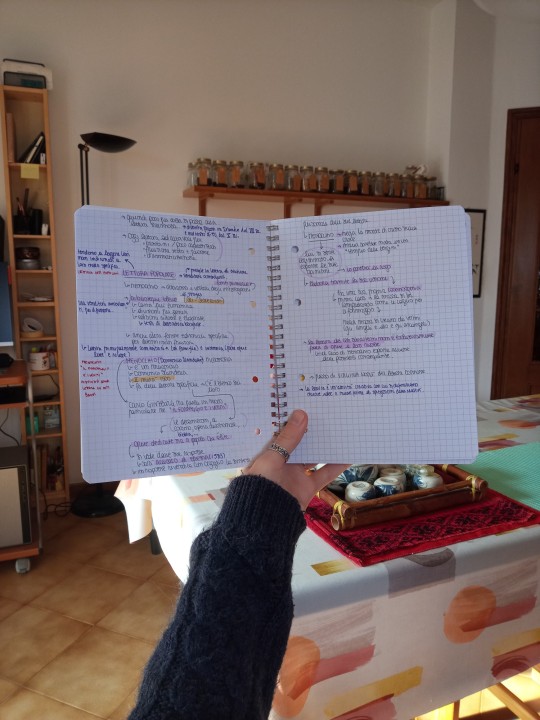
Today was a studying in the kitchen kind of day.
18|03|2023
Today was less productive than it might seem, but I am still pretty tired for some reason. In the morning I went to help my brother in the store, but there weren't lots of people so we ended up playing cards between custumers. In the afternoon my goal was mainly to plan a little bit the weeks ahead, since I have an exam coming up at the very beginning of April. I also started my first review of the notes I took, but I just did a little bit. I again didn't journal even though I know I should get back to it, but my mental brain just wasn't there. Instead I started to work on the April spreads in my bullet journal. It's something that I find very relaxing, and that helped a lot.
Productivity:
worked in the morning
posted this update for the jumbo reading challenge
booked my history of libraries and reading exam
started rereading my notes
worked on my bullet journal
did a bit of study planning
practiced Irish on duolingo
continued to listen to the audiobook of Peter Pan
Self care:
read first thing in the morning in bed
worked on something creative to relax my brain
#studyblr#studyinspo#university#uniblr#studying#student life#book#bookblr#journal#notebook#notes#handwritten notes#productivity#productive day#journaling#mine#the---hermit
259 notes
·
View notes
Note
Hi hon, could you talk more about finding my own ‘dream girl archetype’ & creating ‘my personal manifesto’ as you mentioned in this post? 💌🌹
Gladly! Some notes on creating your own dream girl archetype and personal manifesto are below. Lmk if you need anything else x
How To Build Your Own Dream Girl Archetype:
Reflect on your role models: These can be TV characters, celebrities, public figures, or, even better, those you look up to in real life. What qualities and characteristics about them do you admire and want to emulate? Is it their poise, work ethic, their personal strength, confidence, style, general aesthetic, lifestyle, cultural affiliations, career, and hobbies? Make a list of these people or characters with bullet points under each one. If you find a lot of commonalities and find certain qualities on multiple lists, place them on a separate list – this list will become the framework for your dream girl archetype.
Get introspective: After gaining some inspiration from those you admire, it’s essential to look inside yourself to acknowledge the characteristics and personality traits you like about yourself, your natural talents, skillset, and your motivation for wanting to become your dream girl – this desire for self-growth and perseverance should make it onto the list if you’re still reading this! Think about the compliments you receive, especially those that you regularly get from different people who don’t know each other. I find that these types of comments help us learn the most about how we’re perceived in the world. Add all of these characteristics, personality traits, talents, skillsets, etc. to your list.
Acknowledge your dark side: Get comfortable with your shadow self. If you have certain traits or habits holding you back from being your ideal self (i.e. people pleasing, self-sabotage, procrastinating, etc.), become curious and reflect on why you engage in these behaviors or uphold this mindset. Strategize ways to unlearn these characteristics and ways you move through the world that no longer serves you. Create a plan to dig yourself out of these self-destructive thought patterns and actions. Read books, speak with a therapist (if you can), and start journaling to come up with creative solutions to make changes in your daily life to prioritize yourself. Set up your environment in ways to help you win. Own your indulgent side - it makes you human. The sooner you align with your guilty pleasures, the better you get at indulging in them strategically. Have a small sweet treat every day if needed. Keep emotional distance from toxic loved ones. Make your feelings about your current hot hookup self-referential. Block out time to watch your favorite show.
Assert an active role in your life: Create healthy habits to make you feel good. Stop craving others’ approval – no one can be as happy for you as you are for yourself when you succeed. It’s okay to remind yourself we’re all a bit narcissistic – it’s human nature.
Construct your higher self: Once you’ve acknowledged the qualities you need to internalize to become your ideal self, discover the external qualities and habits you need to cultivate to build your dream girl. What does she wear, what’s her career, how does she speak, work through issues, engage in conversation? What are her habits like? Her morning and night routine? What does she read, watch, and listen to? What’s her social life like? How does she spend her leisure time? What does her space look like, her beauty, diet, and self-care routine? What quotes does she live by? Does she know other languages or about certain topics? How do others speak about her? Create as many inspiration boards and lists, journal entries, etc. as you need until you unlock all of these answers. You will know when some new characteristic, routine, or aesthetic resonates.
How To Write Your Personal Manifesto:
Essentially, this document (can be a journal entry, notes app entry, Google doc, etc.) is an amalgamation of your values, principles, habits, and boundaries. It’s a written reminder to yourself of who you truly are, decide to be, and promise to yourself to stick by your values no matter who tries to tear you down.
Create a mission statement of your ideal self and the qualities that validate this narrative. Essentially, practice the law of assumption by creating a series of personally-tailored affirmations that describe your self-concept and the woman you choose to be.
Write out all of the qualities listed above that you admire about yourself and emulate in your daily life. Affirm this self-concept. Feel free to use specific personal affirmations and attach related behaviors to your self-affirming characteristics (i.e. I make it my mission to show up with class and confidence in every area of my life. I’m mindful of how I speak to others, choose my words carefully – in person or in writing – and consider the feelings of the other person when engaging in conversation. I take my appearance seriously and aim to embody a seductive and alluring presence. I maintain a healthy diet, make almost all of my meals from fresh ingredients, go on long walks daily to take care of my body, tailor my closet with streamlined clothes made of high-quality fabrics that fit my body well, indulge in my makeup and beauty routines daily alongside wearing my signature scent. I’m an intellectual whose dedicated to learning more about the world every day – I read at least 10 pages of psychology, personal development, or a business-related book daily, etc.).
List out your boundaries and non-negotiables with yourself. Feel free to get specific with your boundaries to include all aspects of your life – with your work, family, friends, intimate relationships, dating, food, style, self-care habits, etc. Validate your needs. Add your ‘why’ to each of these boundaries and priorities to help you internalize them and to motivate yourself to uphold these standards despite any self-doubt or external criticisms.
#femme fatale#dark femininity#high value mindset#dark feminine energy#the feminine urge#feminine energy#high value woman#it girl#hypergamy#hypergamous#ideal self#self concept#self growth#self healing#note to self#life advice#girl advice#mindset#loa#loa affirmations#manifesation#higher self#self improvement#self respect#success mindset#personal branding#female excellence#goal setting#femmefatalevibe
772 notes
·
View notes
Text
My Sunday reset routine
Sunday is my rest day. It's the one day a week I prioritise for myself. I like this day to be slow and peaceful to help me relax from the previous week and prepare for the coming week.


Change bedding and pillows. I also apply a little lavender oil onto my pillows to keep them smelling fresh and help me to sleep better.
Make myself a matcha or tea.
Clean room and organise bag for coming week.
Do a full skincare routine + a face mask.
Make myself three delicious homemade meals, full of vegetables and fruits.
Dust room
Open windows and light candles or incense to help air out the space.
Clean phone/laptop/ipad. Delete old emails and photos, sort out online calendar and check schoolwork for next week.
Do morning and evening yoga.
Read a book I've been wanting to read, something that's been on my to be read for a while.
Do something creative like art or writing.
Make a new bullet journal spread for the next week.
Plan meals and workouts for the week.
Clean mirrors and windows.
Water and mist plants.
Plan my outfit for the next week.
Watch a comforting show like Gilmore girls or a sitcom.
Do a gentle Pilates workout.
Drink lots of water (add ice and lemon to make it more fun and refreshing).
Apply a hair mask + oil scalp and ends.
Do my everything shower and put on a calming playlist.
File and paint nails. When dry apply oil and favourite hand cream.
Put on pretty pyjama set and comfy socks/slippers.
Change and wash face and body towels.
Sleep in and let my body fully rest.
Get outside and go on a hot girl walk.
Spend extra time on my body and skin care routines.
Eat slowly and mindfully.
Spend time completely alone, relaxing and disconnecting.
Get a nice and early night so to start the week feeling completely refreshed and relaxed.

Thank you for reading and have a wonderful day! All my love, mj.
#glow up era#that girl#glow up#self care#self development#glow up journey#self love#slow living#slow mornings#it girl#girlblogging#pink pilates princess
76 notes
·
View notes
Text

🎂 happy birthday to the man, the myth, the legend; dynamight, katsuki bakugo. 🧡💥
it might sound sappy, but finding love in writing again is all thanks to this silly little guy. i didn’t pick up a pen to write in almost a decade, keeping all my daydreams locked in my mind. i’ve loved bakugo since i first started watching & reading my hero way back in 2016, easily becoming one of my favorites. he’s relatable in a lot of ways, having been a wild teen full of rage and learning to contain those strong feelings myself - it brought comfort to me. the fandom space was tumultuous and crazy, but i stuck it out and tried to keep in my own lane. at the end of 2023, i started reading fics again. i rediscovered something i loved and didn’t even know i put back on the shelf for so long. the start of 2024, i bit the bullet and started writing again for the first time since filling journals with rambles and collages. finding friends in this space made me feel understood, that this is a form of media that not only brings joy, but offers comfort and healing. something my younger self always ran from because everyone said ‘that’s weird.’ i’m not scared of that now.
i know you’re the fictional man in my head, but that doesn’t change how much you’ve helped me, truly. finding comfort in you is the best thing i’ve done for myself in a long time.
he reignited a spark in me that i didn’t think i possessed anymore. so thank you, katsuki. thank you for giving me that creative fire again. 🔥
love you to the moon and to saturn, blasty. 💜
art by @themetalhiro ✨
#this is sappy af but like idk#a love letter of sorts??#he brings me joy#and i wanted to get it off my chest#happy birthday bakugo#thank you for existing#katsuki bakugo#my hero academia#bakugo x reader#bakugou x reader#katsuki bakugo x reader#katsurei#☆.explodingstars#☆.rei chats
48 notes
·
View notes
Text
Start a Dream Journal
I know what you’re immediately thinking, “but I don’t remember my dreams!” don’t worry, that’s common. I also didn’t really remember my dreams when I started. Here’s the fun part, you weirdly get ‘better’ at remembering the more you write them down. And the sooner you write it down after waking, the more you will remember—don’t walk away thinking you’ll still remember after breakfast or showering, you won’t. Trust me.
My creative writing prof encouraged us to all start dream journals because dreams are amazing sources of weirdness and creativity we just wouldn’t be able to achieve in our waking lives. Some of my best ideas have come out of my dreams—or at least parts of them. A feeling, a place, a character.
You can either keep a little journal next to your bed, or lots of people record dreams in their phones. I write in bullet points, and make note of the date I had the dream. Some people scribble down a few points and then go back later and fill it in, using their initial notes to remember the details. Others write paragraph form. You can even, if it helps, write it out as a text to a friend and then screenshot it for later.
They won’t all be winners (in fact, lots of the ones I record I never look at or think about again), but the ones that are interesting may help influence a project later down the line, or inspire a creative idea, or become a funny line of dialogue. My point is that you have this unlimited source of idea generation and you can literally do it in your sleep, why not take advantage?
Good luck! Tell me your weirdest dreams in the tags!
#writing#writers#writing tips#writing advice#writing inspiration#creative writing#writing community#books#film#filmmaking#screenwriting#novel writing#fanfiction#writeblr#dream journal#dreaming#start a dream journal
203 notes
·
View notes
Text

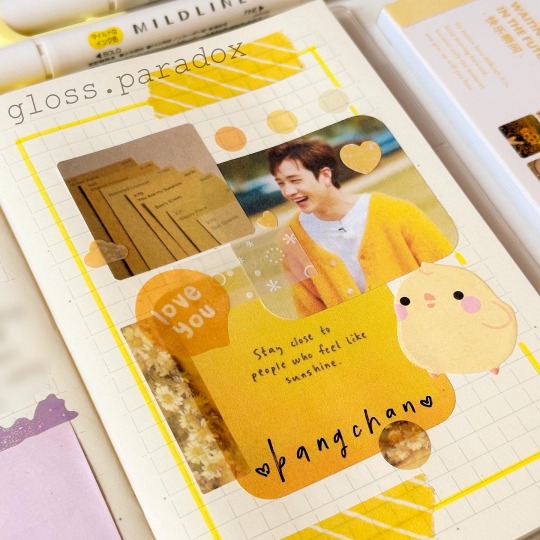
20240124 // sun sparkle ✨
it's been about a year since i went on this tumblr account. back in 2022, i lost my grandma to dementia/alzheimer's. i was her main caretaker so her passing greatly affected me. i hit the hardest creativity block and even stopped bullet journaling.
a month before my grandma's one year death anniversary in 2023, i lost one of my best friends. we were internet friends who shared a bond through our love of kpop. we met through twitter back in late 2013. we went from talking through DM's, snapchatting, and then texting everyday. Losing her shattered me.
sadness and grief consumed me entirely. i stopped journaling and allowed my stationery and journals get covered in dust. but in november 2023, i decided one day to start journaling about my day and it really helped me. my creativity block began to chip away and honestly, it still exists but not the way it used to be.
i got a new desk in my room and i moved my computer and stationery that was in my parents' room into mine. being surrounded by my materials made a huge difference with my mental health. i started journaling again and i'm even waiting for my new bullet journal to come in the mail.
the grief comes back in waves, little by little, but i'm doing a bit better in trying to keep myself together. i'm picking up the pieces of myself that i lost and slowly falling back in love with journaling.
-
-
-
follow me in my socials (*´꒳`*)
instagram
youtube
tiktok
#bullet journal#bujo#bujoblr#studyblr#kpop#kpop journal#journal#journal spread#stray kids#skz#stay#lovestay#creativity#aesthetic#organization#stationery#lifestyle#/glossparadox
22 notes
·
View notes
Text
Pen and Paper Planning
Maybe you like me are endlessly drawn back to pen and paper. I have often felt more at home in a good notebook. For a long time I thought there just weren't many options for notebook systems in comparison to "productivity" apps but over the years I've collected a number of them that I pull inspiration from for my own system. I've been told my little compilations are helpful so I thought I'd share what I've found here with some notes about each.
Bullet Journal
The OG. I think bujo has gotten a bad rap by people who've only every interacted with it via aesthetic routes like instagram. I found out not to long ago that there are people who don't know what the original system entails at all so I thought it was worth mentioning here.
Check it out here.
I recommend it less as a "productivity" system and more as a style of rapid/micro journaling. Does journaling feel like it takes forever and just isn't worth it - this is the system for you. When you go into it with that mindset, it's a lot easier to get the benefits. Wouldn't really recommend it for full blown tasks management and planning but the creator is upfront he never really intended it for that.
Everbook
This is more of a folio style as opposed to a notebook system but I think there are aspects that translate nicely to notebooks. It's definitely more of a productivity system too - very GTD influenced according to it's creator. I like it for it's modular approach to tasks, inspiration, and tracking.
Check it out here.
I recommend this if you like multi-notebook systems and are focused on getting tasks done more so than reflection/introspection.
Analog by Ugmonk
Basically a glorified notecard but this one has been a real game changer for me with regard to my daily tasks. I keep my today card clipped to the cover of my journal. You don't need to buy their fancy system for it at all and lots of people have hacks of it. Easy to combine with 1-3-5 Lists and the Bento Method as well.
Check it out here.
I recommend it for people who prefer a more flexible way of planning their days than what traditional planners offer.
Strikethru
I've not gotten to try many aspects of Strikethru yet but there are some I'm definitely looking to incorporate in another journal. Strikethru is a much more task oriented system than a bullet journal. It features a "live list", "dump" "vault" and calendar. I think it best replicates what you do what many to-do apps. They have their own journal you can buy but it can be set up in your own notebook.
Check it out here.
I recommend this for people who are doing large projects with lots of moving parts.
Theme System by CPG Grey
I love CPG Grey's ideas about yearly and seasonal themes. He created a notebook to compliment those ideas. It basically is composed of a section on fleshing out your themes, daily reflection pages, and habit tracking. I like the light direction while still being freeform enough for most goals.
Check it out here.
And here.
I recommend it for people who's primary use case is self improvement oriented. If you're looking to move the needle forward in some area of your life, themes are a great way to start.
Commonplace Book
I think the best way to think of a Commonplace Book is that it's a sketchbook for ideas. I think too often with digital systems it's easy to get caught up in worrying about capturing all of our ideas or optimizing them to be found again - which only really adds stress and unnecessary complexity. What I like about a commonplace book is not only it's usage throughout history but it's simplicity.
Check it out here.
And here.
I recommend this for people who are looking to do a lot of creative or intellectual work and don't want to get distracted by screens to capture what inspires and moves them. Also for people who prefer to refer to their inspiration in a more tactile way.
Maurice Moves' Notebook
When I first found this method, it had very few views. When I went to look it up again, it had taken off. I'm so glad because it feels like an underrated system that can be easily paired with some of the other. It's basically a series of pages he uses to work through goals or just directions he wants to move in life. I've never see a system that's both so orderly and thorough. I especially appreciate is way of working backwards from his desired results to develop his plan.
Check it out here.
I recommend this for people who are trying to achieve big things but aren't totally sure how to get here. Seems very neurodivergent friendly too depending on what you personally excel with.
1-3-5 Lists
I first learned about a similar concept from Esme Weijun Wang's ebook "Productivity Journaling with Limitations" but I can't seem to find it on her website anymore. This website has one version of it but the version I've been using is slightly different.
The first task is my "win the day task" - if I only do this it was a productive day. It's achievable based on the resources I have that day. On low energy days , the task might be a simple chore like laundry or a health activity like walking. On a high energy day, it's usually something that moves me forward in some way - tackling projects like redoing my room or organizing all of our papers. Most days are inbetween though.
The next three have historically been "to not cause myself further trouble" tasks but I've been experimenting with making them one home/work task, one health task, and one relationships task as mentioned in this Ali Abdaal video (in Part 3).
The next five to six tasks are usually just easy wins - things I can get to if I feel like it but I feel no pressure to complete.
I recommend this system for people who are working with variable energy, health, time, or other resources. I could see it being helpful for folks with children or who are caregivers as well. I've found it useful as someone with chronic illness.
Sorry this section is a bit of a mess, when I originally put it on here I thought I could just link to Wang's ebook but alas. If anyone has the link, please drop it in comments.
Bento Methodology
This is another one that can be paired with another system. While the video I link to is talking about it in terms of an app, I think it's similar to the 1-3-5 system in that you can just use it inside of any other to-do list or task system you might be using. I appreciate it's nudge to do deep work and it's clear criteria for each compartment. I use this when I have more energy and want to use it to the best effect. Whenever I use it I always feel like I had a really meaningful day in terms of my efforts.
Check it out here.
I recommend this for people who want some structure to their day but still want flexibility from day to day to pick what they work on.
And I think that's most of them. I hope something here inspires you to pick up a notebook and get to writing. Best wishes!
111 notes
·
View notes
Text
...I ran across a post that was very anti- "aesthetic" journaling/planner keeping.
The thing is, they made good points and everything they said was totally valid. But....
Damn, man. Some of us get a little dopamine hit from putting stickers next to "dentist appointment". I know there's an issue when it's perceived that aesthetic journaling is the only "acceptable" kind of journaling. I get that the bullet-journaling system it was initially meant to help ND folks actually keep track of important things.
However, that little dopamine hit when I pick out stickers fucking helps. And sometimes--when I want to make something but nothing else is working--I can actually use it as a creative outlet.
OP isn't wrong to be frustrated with the Pintrestification of bullet journaling, but I think calling it ableist is maybe ignoring the ND folks that those aesthetic aspects do help.
TL;DR--if you like your aesthetic planner/bullet journal, if it helps you in your day-to-day, then good for you. Keep on keeping on. If you're curious but all other "planners" have failed you, I say give it a try. You can even DIY if you don't like buying. Find some stickers you like, and celebrate small successes. Hell, use the damn stickers as a reason to fill out the weekly plan. (I go week by week, but you can do whatever level of effort works for you.)
It does not work for everyone--I will in no way claim that it does--but if you found those little rewards from your school days helpful, give it a try. (Hell, I didn't even used to like stickers. Now it's one of my small joys.)
57 notes
·
View notes